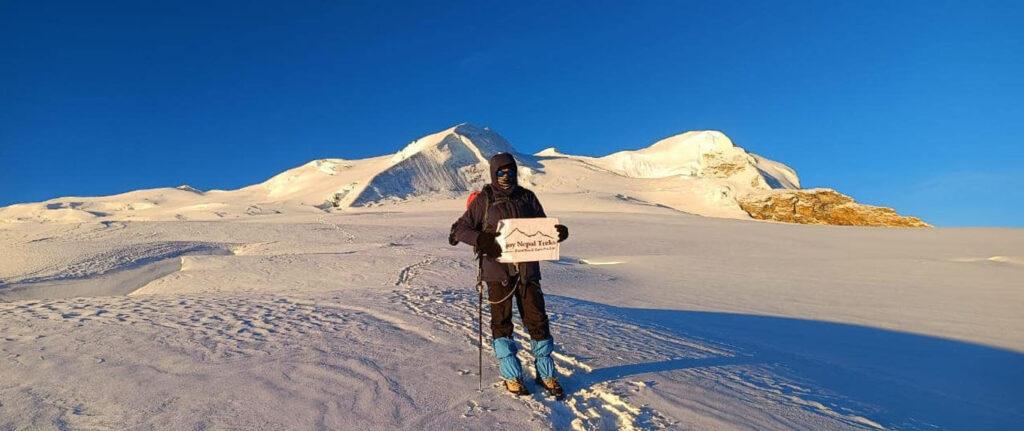Mera Peak Climbing Guide: Your Ultimate Adventure to Nepal’s Highest Trekking Peak

Mera Peak, standing at 6,476 meters (21,247 feet), is the highest trekking peak in Nepal and a thrilling destination for mountaineers seeking adventure beyond the popular trekking routes. Known for its stunning panoramic views of some of the world’s tallest mountains, including Everest, Lhotse, and Makalu, Mera Peak offers a unique blend of high-altitude trekking and climbing challenges. This guide provides essential information for anyone looking to tackle Mera Peak, from preparation and acclimatization to the climb itself.
Preparing for the Climb
1. Fitness and Training Climbing Mera Peak requires good physical fitness and some mountaineering experience. Training should include cardiovascular exercises, strength training, and endurance workouts. Activities like trekking, running, and hiking with a weighted backpack will help build the stamina needed for the climb. Additionally, practicing basic mountaineering skills such as using crampons, ice axes, and ropes is essential.
2. Gear and Equipment Proper gear is crucial for a successful climb. Essential equipment includes:
- Climbing Gear: Crampons, ice axe, harness, and climbing rope.
- Clothing: Layered clothing for cold weather, including a base layer, insulating layers, and a waterproof outer layer.
- Footwear: High-altitude boots suitable for crampons.
- Safety Gear: Helmet, headlamp, gloves, and a first-aid kit.
3. Permits and Logistics To climb Mera Peak, you’ll need to obtain a climbing permit from the Nepal Mountaineering Association (NMA). This can be arranged through a licensed trekking agency in Nepal. It’s also advisable to have travel insurance that covers high-altitude climbing.
The Trek to Mera Peak
1. Route and Itinerary The standard Mera Peak climbing itinerary includes a trek through the remote and beautiful Hinku Valley. The journey typically starts from Lukla, following the trail through lush forests and traditional Sherpa villages before reaching Mera Base Camp. From there, climbers ascend to High Camp and then to the summit. The trek usually takes around 15-20 days, including acclimatization and rest days.
2. Acclimatization Acclimatization is crucial to prevent altitude sickness. The climb typically involves several acclimatization days, with gradual ascents and descents to allow your body to adjust to the increasing altitude. Pay attention to your body and communicate with your guide if you experience symptoms of altitude sickness.
3. Summit Push The final push to the summit involves a steep ascent from High Camp, often undertaken in the early morning to avoid the risk of avalanches and strong winds. The climb requires technical skills, including traversing snow and ice slopes. The summit day is demanding, but the breathtaking views of the Himalayan giants make it all worthwhile.
Safety and Considerations
1. Weather Conditions Weather in the Himalayas can be unpredictable. Check weather forecasts regularly and be prepared for sudden changes. Winter and spring are the best seasons for climbing, with more stable weather conditions.
2. Hiring a Guide Hiring a certified and experienced guide is highly recommended. They provide valuable expertise, help with navigation, and ensure safety throughout the climb. Guides are familiar with the route and can assist in case of emergencies.
3. Health and Safety Stay hydrated, maintain a healthy diet, and follow your guide’s instructions to minimize health risks. Carry a basic first-aid kit and be aware of symptoms of altitude sickness, such as headaches, nausea, and dizziness.
Conclusion
Mera Peak offers an exhilarating climbing experience with awe-inspiring views and a sense of accomplishment. With proper preparation, physical conditioning, and the right equipment, the climb can be a rewarding adventure. Remember to respect the mountain, follow safety guidelines, and enjoy the breathtaking beauty of the Himalayas as you take on Nepal’s highest trekking peak. Whether you’re an experienced mountaineer or an ambitious trekker, Mera Peak promises an unforgettable journey.
- Art
- Causes
- Crafts
- Dance
- Drinks
- Film
- Fitness
- Food
- Jocuri
- Gardening
- Health
- Home
- Literature
- Music
- Networking
- Alte
- Party
- Religion
- Shopping
- Sports
- Theater
- Wellness
- IT, Cloud, Software and Technology


